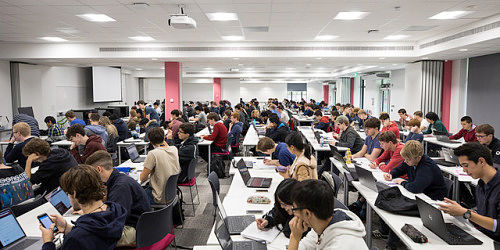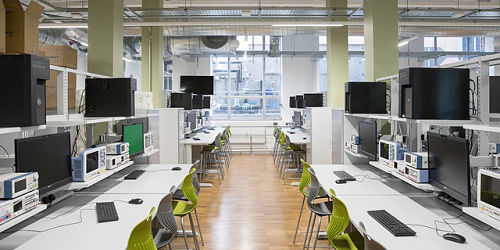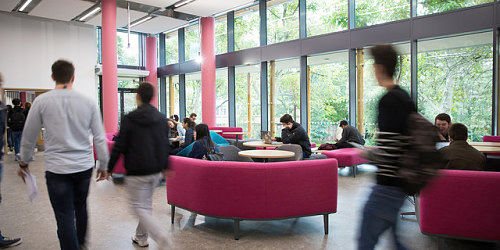Problem
Queens Building at the University of Building presents lots of challenges for minimising transmission, many of which are common across buildings of similar usage at the University, hospitals, or in companies and office environments.
One of the key issues lies in people moving quickly and efficiently around the building. Queens is high-throughput, with 5,000-10,000 users every day, all needing to use the same corridors, rooms, and spaces.
In a world of social distancing it won’t be possible to hold doors open for others. This means we need a way for people to quickly and cleanly open and close access to a variety of spaces, while preventing physical contact with doors, and allowing high throughput of people.
While in some cases the solution is simple – to prop the door open – Queens Building has many cases where that isn’t possible.
Design Brief
Design an access toolkit for Queens Building and other buildings like it, consisting of a variety of door fixings and user-interface devices for clean access to many different types of spaces.
We need several types of solutions for different types of access (or ideally a few solutions that are suitable for many!):
- Lab access doors, that need to prevent access to potentially dangerous rooms and equipment. These are often heavy and also have separate card-controlled access, making one-handed operation important. Some are push/pull, and some are lever-action handles.
- Code-entry doors. Many doors have a button-based code entry system, and must remain closed and locked while not in use. These often require one hand for the code and one for the handle.
- Fire doors. Many doors in corridors are there to prevent the spread of fire and should be kept closed when not in use. These push/pull doors are often large and heavy, and any solution will need to take into account that they are very high throughput. Some are one-direction push/pull, some operate both ways.
- Lecture hall doors. These are often lighter than others, and can be left open while class is entering/exiting. Some are push/pull, some are lever action. Very high throughput (300+ people) in only a few minutes.
- Office doors and other general access. Lower throughput, but very common in the building. These are often lever action and medium weight, and won’t be used by as many unique users.
- Bathroom cubicle doors. Bathroom cubicle doors are often lighter and low throughput, but have the unique challenges of a locking device on the inside. Locks can be bolt or twist activated. Doors themselves can be either push/pull, or lever action.
Other Considerations
Queens Building has very good access to 3D printing with a lot of expertise. 3D printed solutions are suitable for us. However, many buildings and companies are not lucky enough to have our resources, and the best solutions will be compatible with several different manufacture methods with minimal modification.
For Queens Building, high throughput could often mean 300+ people in a matter of 3-5 minutes, each needing to individually access the door.
We often find that for the best solutions it’s as important to think about how designs change behaviour and the way that we approach the problem. The scenarios we’ve set out assume that doors under social distancing will be used in a similar way to the past, but we would welcome ideas that challenge that thought and encourage users to modify behaviours to safer, cleaner alternatives.
General Guidelines
Remember, all solutions should follow the guidelines below.
Solutions need to embody the values of project clean access and they should ideally follow the following design guidelines:
- Seal away the transmission site – all devices should in some way enclose or seal away the parts that make contact with potential transmission sites.
- Be simple, robust, cheap to make and use.
- Either:
- make use of common household or workplace items as part of the device, to save on cost and increase accessibility to all. For example, pens and USB sticks with lids to operate access devices and seal away transmission sites.
- OR be manufacturable by locally available technologies
Submission Guidelines
To be efficient with your time and to reduce the burden of paperwork our submission guidelines are as light-weight as possible, including a short overview/description, details of use, and the all important CAD/CAM models. We encourage the use of photographs and images and just enough information to present the design, its installation and operation. Given this, contributions should be a simple email adhering to the following minimum submission guidelines:
- Provide enough information to describe the design (purpose, typical applications, etc), ideally in the form or a short written summary.
- Contain instruction / guidance for use, ideally in the form of photos or videos.
- If to be digitally manufactured, CAM tractable files be provided for reproduction (eg STLs for 3D printing) and CAD tractable files (STEP or IGES) so designs can be customised or further developed if necessary.
All published designs will be made open access and shared with the global community to aid transition to normality post lockdown. By participating in the Clean Access Challenge you consent to the terms of creative commons license CC BY 4.0.
All submissions should be submitted to project-clean-access@bristol.ac.uk by the end of 30/06/2020.
Get Involved
If you would like to get involved, get more information, or submit your own ideas for our design repository, send us an email at project-clean-access@bristol.ac.uk




